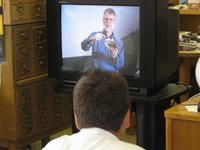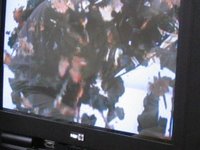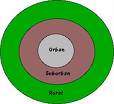
I will never feel quite the same when I walk on a pile of leaves. Today an 8th grade class got to meet Dr. Timothy Pearce, Assistant Curator at the Carnegie Museum of Natural History in Pittsburgh PA and head of their Mollusk section. Our students were able to enjoy the view from a front row seat while Dr. Pearce, whose research focuses on terrestrial land snails, sorted a fresh sample of a Pennsylvania forest floor and identified life forms that many people never notice. The students learned a lot about this second largest group in the animal kingdom (only insects are larger). They got to see up close and personal snails, slugs and clams that are all members of this species called mollusks.

They had plenty of questions for Dr. Pearce too. What do they eat? How do they mate? This was all part of a Meet the Scientist videoconference program at the Carnegie Museum. Dr. Pearce who besides being a leading expert on the subject of mollusks (He literally co-wrote the book "Mollusks: A Guide to their Study, Collection and Observation") also sees himself as a good will ambassador for getting others to appreciate these "under-appreciated” animals. The students got to see a snail’s beating heart. They also were able to observe through close up cameras the critters that can be found in a fresh leaf sample. Dr. Pearce by using three increasingly fine filters, which looked to me like the flour sifters used in baking, demonstrated how to find life in a leaf litter.

Dr. Pearce invited the students to join him in identifying mollusks in the New York City area. Yes, we have nature preserves too. We a’re not all concrete. He e-mailed the students a classification guidebook. The class plans to go on a trip and collect their own leaf samples. One of the interesting things the students learned is how the mollusk habitat is being threatened. In Pennsylvania they are building a road right through a mollusk habitat. When winter comes and the salt spreaders come down the highway the snails habitat will be threatened. And every kid knows what happens when you put salt on snails or slugs. They shrivel up and eventually dry up."
 I will never feel quite the same when I walk on a pile of leaves. Today an 8th grade class got to meet Dr. Timothy Pearce, Assistant Curator at the Carnegie Museum of Natural History in Pittsburgh PA and head of their Mollusk section. Our students were able to enjoy the view from a front row seat while Dr. Pearce, whose research focuses on terrestrial land snails, sorted a fresh sample of a Pennsylvania forest floor and identified life forms that many people never notice. The students learned a lot about this second largest group in the animal kingdom (only insects are larger). They got to see up close and personal snails, slugs and clams that are all members of this species called mollusks.
I will never feel quite the same when I walk on a pile of leaves. Today an 8th grade class got to meet Dr. Timothy Pearce, Assistant Curator at the Carnegie Museum of Natural History in Pittsburgh PA and head of their Mollusk section. Our students were able to enjoy the view from a front row seat while Dr. Pearce, whose research focuses on terrestrial land snails, sorted a fresh sample of a Pennsylvania forest floor and identified life forms that many people never notice. The students learned a lot about this second largest group in the animal kingdom (only insects are larger). They got to see up close and personal snails, slugs and clams that are all members of this species called mollusks.  They had plenty of questions for Dr. Pearce too. What do they eat? How do they mate? This was all part of a Meet the Scientist videoconference program at the Carnegie Museum. Dr. Pearce who besides being a leading expert on the subject of mollusks (He literally co-wrote the book "Mollusks: A Guide to their Study, Collection and Observation") also sees himself as a good will ambassador for getting others to appreciate these "under-appreciated” animals. The students got to see a snail’s beating heart. They also were able to observe through close up cameras the critters that can be found in a fresh leaf sample. Dr. Pearce by using three increasingly fine filters, which looked to me like the flour sifters used in baking, demonstrated how to find life in a leaf litter.
They had plenty of questions for Dr. Pearce too. What do they eat? How do they mate? This was all part of a Meet the Scientist videoconference program at the Carnegie Museum. Dr. Pearce who besides being a leading expert on the subject of mollusks (He literally co-wrote the book "Mollusks: A Guide to their Study, Collection and Observation") also sees himself as a good will ambassador for getting others to appreciate these "under-appreciated” animals. The students got to see a snail’s beating heart. They also were able to observe through close up cameras the critters that can be found in a fresh leaf sample. Dr. Pearce by using three increasingly fine filters, which looked to me like the flour sifters used in baking, demonstrated how to find life in a leaf litter. Dr. Pearce invited the students to join him in identifying mollusks in the New York City area. Yes, we have nature preserves too. We a’re not all concrete. He e-mailed the students a classification guidebook. The class plans to go on a trip and collect their own leaf samples. One of the interesting things the students learned is how the mollusk habitat is being threatened. In Pennsylvania they are building a road right through a mollusk habitat. When winter comes and the salt spreaders come down the highway the snails habitat will be threatened. And every kid knows what happens when you put salt on snails or slugs. They shrivel up and eventually dry up."
Dr. Pearce invited the students to join him in identifying mollusks in the New York City area. Yes, we have nature preserves too. We a’re not all concrete. He e-mailed the students a classification guidebook. The class plans to go on a trip and collect their own leaf samples. One of the interesting things the students learned is how the mollusk habitat is being threatened. In Pennsylvania they are building a road right through a mollusk habitat. When winter comes and the salt spreaders come down the highway the snails habitat will be threatened. And every kid knows what happens when you put salt on snails or slugs. They shrivel up and eventually dry up."


